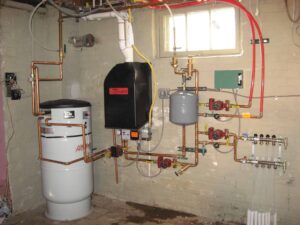The Fat List of 122 Energy Saving Tips, Products and DIY Projects
I’m not gonna’ lie. This is an exhaustive list of energy saving tips, ideas, products and projects.
It’s not a 2 minute read.

It includes the lazy:
“Blackout nights. Turn tablets, phones and laptops off at night.”
To the crazy:
“Build a solar charger for your phone for less than a fiver.”
So, you might want to bookmark this guide and refer to it later. Or at least get a cuppa’ (but see tip 1 first).
And of course, if you have energy saving tips, products, ideas and projects you’d like to share, leave a comment at the end.
Browse this list by category:
Energy Saving Products
Energy Saving With Food And Drink
Energy Saving DIY Projects
Saving Energy Outdoors
Conserving Energy With Insulation
Saving Energy Via Central Heating Systems
All Other Energy Saving Tips
Energy Saving Products

1. Install new heating controls that have energy efficiency features built into them to help conserve energy.
Read more from The Money Principle.
2. Install LED lighting (up to 80% efficient)
Read more from Family Budgeting.
3. Install an eco-button to reduce electricity on appliances that are not currently being used.
Read more from The Savvy Scot.
4. Purchase a programmable room thermostat.
Read more from PT Money.
Saving Energy With Food and Drink

5. Your fridge doesn’t need to be any colder than 4° C, turn it down if it’s colder than this.
6. Check the energy rating on all appliances you purchase, you want A-rated products only.
7. Halogen ovens use around 70% less electricity than standard ovens. Think about this next time you purchase one.
8. Cook in batches. If you already use a slow-cooker, cook enough for another meal and freeze it (which also fills the void in the freezer).
9. Only buy the size fridge freezer you need. Cooling air, costs money.
10. After your dishwasher finishes the wash cycle, let the contents air dry rather than using the drying cycle.
11. Ovens use lots of energy, stop opening that door!
12. Like heated plates? Use them as a lid for pans for 30 seconds each rather than using a microwave.
13. But if you prefer to microwave, wipe them over with water first, as the heat will distribute evenly.
14. Your freezer can be set at 18° C, turn it down if it’s set below this (some will be set at up to 21° C
15. If you have a dodgy fridge door, or a deteriorating seal, use a fridge door latch to stop cold air being released.
16. Don’t overfill a kettle. Only boil the amount of water that’s needed. Up to £7 per year in savings.
Read more from the Frugal Family.
17. Fill up your kettle directly after use. This will help warm up the water ready for your next cuppa’
18. Invest in a slow cooker. They use 3x less electricity than a normal oven.
Read more from Miss Thrifty.
19. Clean the coils on the back of your fridge/freezer. This will help to improve efficiency.
20. Keep heat in when cooking. Use lids on all pots and pans.
21. Reduce the need to defrost in the microwave where possible. Remove items from the freezer prior to cooking.
22. Use a chest freezer over a fridge/freezer where possible, they are more energy efficient.
Read more from Budgets are Sexy.
23. Defrost your freezer. Keeping ice cold is a waste of money!
Read more from First Utility.
24. Limit use of an extractor fan and open windows instead (in summer months).
25. Don’t use the oven for re-heating, use the microwave. The oven uses a tonne of energy!
26. Clean filters on dishwashers, washing machines and dishwashers to improve efficiency.
27. Use the right size pan, for the right size hob. Reduce heat loss.
Read more from Nourished Kitchen.
28. Switch off the hob a few minutes before food is finished cooking. It will continue to cook.
Read more from Green Living Ideas.
29. Stop pre-rinsing dishes before turning on the dishwasher.
Read more from Tree Hugger.
30. Fill your fridge and freezer for efficiency.
Read more from Moral Fibres.
31. Keep fridges and freezers away from a direct heat source (radiators), as it will mean it has to work harder to cool contents.
Read more from Top Ten UK.
Energy Saving DIY Projects

32. Use a rain harvesting system to collect water to use in the garden.
33. Create your own solar panels. This handy little video will help you out.
34. Make your own wind turbine. This video from YouTube will help get the job done.
35. Build a solar charger for your phone for less than a fiver.
Read more here.
36. Build a water powered clock. Yup. That’s actually a thing.
37. Getting hot? Build a solar powered fan.
38. Use a lot of battery power? Get a solar powered battery charger.
39. Lucky enough to have a hot tub, use a solar powered hot tub heater!
40. Build a solar WIFI booster for your garden. OK. Maybe not as big as this one.
41. Glossy paints will reflect light much better, meaning you won’t have to have high wattage bulbs.
42. Convert your exercise bike into a generator. You do exercise, right?
Saving Energy Outdoors

43. Junk-mail wedged open your letterbox and left your house cold? Use a post-box instead.
44. Solar outdoor lighting can be used for places like pergolas and BBQ seating areas. You don’t need to rely on mains electricity.
45. Use a rockery as a lighting feature. Paint the rocks with glow in the dark paint.
46. Apply self-adhesive draught proofing strips to windows.
47.Use hinged keyhole covers that drop down after a key is removed.
48. Use a letterbox brush that will give some protection from the outdoor elements.
49. Hook up a hose pipe to your waste water pipes, filtering into a water butt in the garden.
50. Avoid using the dryer in summer months and hang clothes outside. They’ll be dry in no time.
51. Maximise the use of a BBQ where possible.
Conserving Energy With Insulation

52. Chaulk (decorator’s filler) any gaps in skirting boards and floorboards.
53. Use decorator’s filler to fill gaps where pipework goes through walls or floors.
54. Make sure you draught proof the door connecting your garage to your property.
55. If you have flooring work done, ask for the floorboards to be insulated, this could save £40-50 per year.
56. After confirming there’s nothing more serious taking place, use cement to fill cracks in walls
57. Add blinds on small windows (such as your back door or utility) to help keep heat in, and draughts out.
58. Insulate the bottom of water cylinders, not just the top. You’re losing a lot of heat energy through the floor.
59. Save up to £60 per year by insulating your hot water cylinder.
Read more from The Resident.
60. Draft excluders can save you up to £25 per year.
From Lime Property.
61. A Chimney Sheep can reduce heat loss by 4%.
Read more from Chimney Sheep.
62. Upgrade windows and reduce heat loss by up to 20%
Read more from Efficient Energy Saving.
63. Save up to £145 per year by insulating your loft
Read more from Love Energy Savings.
64. Board out your loft. Not only will this further insulate the area, but it will stop loft insulation being compressed (which reduces efficiency).
65. Use rugs on tiled or hard-floor areas. This will naturally make your house feel warmer, removing the need to increase the heat.
66. Don’t just insulate the loft, make sure the loft hatch is insulated too using insulation strips
67. Get Government funded cavity wall insulation.
Read more from Gov.UK.
68. Check your loft insulation hasn’t degraded over time. Top up if necessary. This could save you £25 per year.
From Be Energy Smart.
Saving Energy Via Central Heating Systems

69. A kinetic fan will help circulate heat around a room, making it feel warmer.
70. Save up to £350 by having your boiler replaced.
71. Install an outdoor sensor and reduce gas usage by 2%.
72. New radiators can improve efficiency by up to 50%.
73. Using TRVs on radiators will allow you to control heat and reduce wastage.
74. Central heating pumps usually have 3 settings. Turning this down (where possible) will reduce electricity consumption.
75. Products such as Radflek will reflect the heat from radiators back into the room (rather than the wall).
76. Install thermostats in a central location. If it’s installed by a door or window, cold drafts will trick it into thinking the room is colder than it is (and cost you more in gas).
77. Turn down the room thermostat by just a few degrees to save energy (and approximately £45/year per 1 degree reduction).
78. Leave room between radiators and furniture, so the heat can circulate around the room.
79. Get curtains turned up so they fit easily behind radiators, rather than in front of them. This will help heat circulate around the room.
80. Using a dual flush system can reduce water wastage by 50%.
81. Tap aerators will mix water with air. Flow rate is reduced but it will seem like pressure isn’t.
82. A smart thermostat allows you to set a max setting from your phone. No amount of finger turning can get it above this setting.
83. A boiler losing pressure is under unnecessary strain. Get it fixed as soon as possible.
84. Get a radiator booster. This absorbs heat from behind radiators and fans it around the room.
85. Get an automatic bleed valve for radiators. Keeping radiators bled is essential to their efficiency.
86. Use a central place to charge devices. Approximately 8% of household energy, is doing nothing. Flick the switch when you’re done.
87. Set heating to come on before you get home (and the temperature rise slowly) rather than putting it on full blast (the later uses more energy).
88. Use a water efficient shower and save up to £50 per year on gas.
Read from the Energy Saving Trust.
89. Fit an efficient shower head and save £40 per year.
From Water Wise.
90. Reduce the pressure setting on your shower.
From Lite Craft.
91. Keep your radiators clean. Heat your house, not dirt!
Read more from Best Heating.
92. Turn radiator valves down or off in rooms that are not being used (and shut the doors).
From Penny Go Lightly.
93. A room thermostat will adjust temperatures inside, there’s not need to turn the stat up when it’s cold.
From Help Me To Save.
94. Save up to 5% on your energy bills by reducing the temperature of hot water on your boiler or hot water cylinder.
All Other Energy Saving Tips

95. Blackout nights. Turn tablets, phones and laptops off at night.
From A Thrifty Mrs.
96. Save 1/3rd of the energy you use by switching your washing machine to 30°C
Read more from Electrical Safety First.
97. Make sure all new appliances are energy efficient. An energy efficient fridge could save you £45 per year.
Read more from Our Property.
98.Feeling brave? Wrap up warm in the winter months.
Read more from Save the Student.
99. Only use your washing machine and dishwasher for full loads.
Read more from Sustainable Baby Steps.
100. Remove clothes from the dryer, just before they are dry. They will be much easier to iron.
101. Don’t leave appliances on stand-by.
From Think Insulation.
102. But if you insist on leaving appliances on stand-by. Use a stand-by saver.
103. Save 18 litres per wash, by using the shower rather than the bath.
Read more from This is Money.
104. Like your parents always said, turn lights off when you leave a room!
105. When heating is off and its light outside, open curtains to let sunlight in.
106. Use lights incorporating motion detectors that automatically turn off when you are out the room.
107. Get a duvet with a higher tog rating for the winter.
108. Appliances on charge, even when fully charged, will continue to drain electricity. Unplug chargers.
109. Away for the weekend, or going on holiday? Turn everything off.
110. Set your smart phone, tablet and laptop to enter a dim or energy saving mode after a short period of non-use.
111. Buying curtains? Make sure you buy thick ones to keep out cold draughts from windows.
112. Energy saving bulbs can save you £2.50 per year, per bulb!
113. Get an electricity usage monitor. You’ll be surprised how much you save when you can see the pennies ticking away!
114. A remote control power strip can be used to turn off multiple devices at once. No more unplugging.
115. A downlight LED can be used in an area such as a hall way, that doesn’t need as much light.
116. Get a shower timer. We know it’s you. Limit yourself.
117. The average bath is 80 litres full. If you are purchasing a new one, look for lower capacity baths.
118. Leave the tap running whilst brushing or shaving? Use the plug and fill the sink up instead.
119. Use the “no heat” setting on your washing machine.
120. A full vacuum cleaner will use more energy than an empty one. Get that thing emptied!
121. Smart meters help you understand energy usage in your home. Get one installed.
122. Install dimming switches for lighting. Turn them down when you don’t need them on full power.
If you need help with heating upgrades to improve energy efficiency, please getting in touch with one our Gas Safe engineers.
What’s Next?
Want a new energy efficient boiler installed? Check out new combi boiler replacement costs here.
If you’ve got some energy saving tips, ideas, projects or projects of your own to share…
Leave them below and we’ll feature the best ones when we update the list.

That is ONE. BIG. LIST! Never came across such an exhaustive list of tips before. We follow most of them with the most recent addition being the smart meter by Ohm Assistant (https://ohmassistant.com/). This is built with machine learning so no sensors in individual appliances and therefore non-bulky and easy to set up. By this, we’re able to monitor the power consumption of our devices on our smartphones.